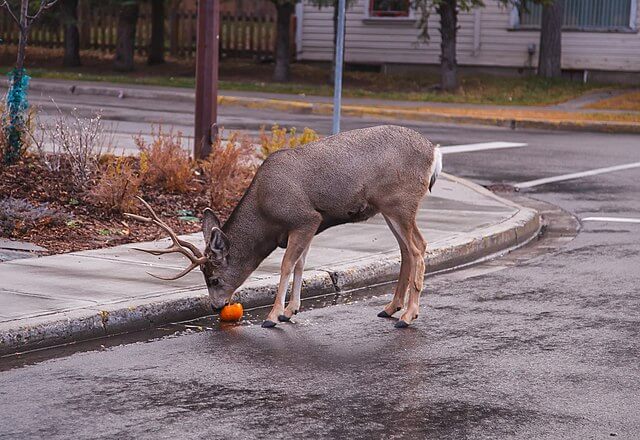Oh, Deer
By Karen Curran
Broadcast 1.18 & 1.21.2023

Urban deer, munching on a pumpkin. Photo by Murray Foubister, CC BY-SA 2.0.
Listen:
White-tailed deer abound in the Great Smoky Mountains National Park, scene of most of my camping and hiking adventures during the many years I lived in Tennessee and North Carolina. Despite that assurance from the park rangers, it was rare that I saw the shy, elusive creatures. After my recent move to Missoula, Montana, however, I was surprised to see deer wandering freely through my neighborhood.
They’re in my yard, in a yard two blocks away, or on someone’s front porch chewing pumpkins. It’s rare that I take my daily four-mile trek without seeing these white-tailed wonders, often grazing near the sidewalk, seemingly unafraid. Once, a young buck whose antlers were entangled in a soccer net was frantically trying to free himself, but a fellow walker called Fish, Wildlife, and Parks to get him the help he needed. These gentle animals stare at me, curious about this two-legged creature who talks to them, while I’m in awe of their graceful bodies and innocent faces accentuated by huge obsidian eyes. They are elegant creatures that, on slender legs, can easily sail over a fence without even taking a running start, and I feel blessed to be able to observe them so closely. I especially love the two fawns that frequent my backyard, affectionately referring to them as the twins.
At a meeting of our new neighborhood’s homeowners, someone commented that the urban deer were a nuisance because they crossed roads in front of traffic and ate people’s landscaping shrubs and trees. I was surprised that not everyone experienced the wonder I felt. True, I’ve never lived in an area where homes were being built close to rural land where wildlife abounds, but couldn’t we all just slow down to enjoy the scenery—which, of course, includes deer? And perhaps folks could choose to adorn their yards with plants that don’t attract deer.
One crisp fall day, two deer were fighting, standing erect and pummeling each other with their front hooves, while a third, smaller doe watched from a distance. Bucks may be expected to spar to display their strength when mating season approaches, but these boxing deer had no antlers and were clearly does. Why, then, were they fighting?
Female deer travel in herds, each headed by an older doe whose responsibility it is to ensure their survival. This leader instructs the younger deer in finding food, water, and shelter. She also chases yearling bucks from the group. Two does may fight to claim this leadership position in their small herd. They may also fight to claim their fawning territory, typically ten to twenty acres. It seemed unlikely, though, that a doe would want to give birth in front of a house on a residential street, which is where I saw the fight take place. Also, fawning takes place in the spring, months in the future.
Could it be that one doe was trying to protect its food supply? It’s a possibility since food becomes less abundant as fall moves toward winter. As I walked closer, they drew apart, their eyes as focused on me as mine were on them. One deer gingerly lifted a foot, attempted to settle it back on the ground, then lifted it again, holding it in midair, possibly injured from the altercation. Knowing there was nothing I could do to help, I lamented as my young grandson often does when distressed: Oh, dear.
Every week since 1991, Field Notes has inquired about Montana’s natural history. Field Notes are written by naturalists, students, and listeners about the puzzle-tree bark, eagle talons, woolly aphids, and giant puffballs of Western, Central and Southwestern Montana and aired weekly on Montana Public Radio.
Click here to read and listen to more Field Notes. Field Notes is available as a podcast! Subscribe on Apple Podcasts or wherever you listen to podcasts.
Interested in writing a Field Note? Contact Allison De Jong, Field Notes editor, at adejong [at] montananaturalist [dot] org or 406.327.0405.
Want to learn more about our programs as well as fun natural history facts and seasonal phenology? Sign up for our e-newsletter! You can also become a member and get discounts on our programs as well as free reciprocal admission to 300+ science centers in North America!












